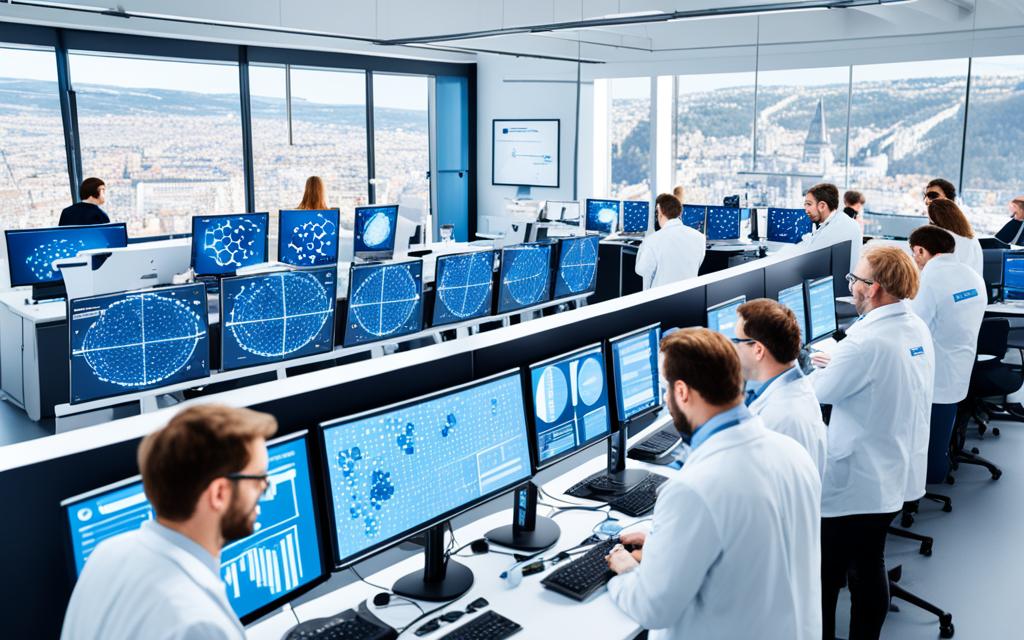Welcome to an exciting exploration of the transformative capabilities of Artificial Intelligence (AI) and Machine Learning (ML). As these technologies continue to push the boundaries of innovation, their impact can be seen across various industries, reshaping the way we work and live.
AI and ML are not just buzzwords; they are driving forces behind groundbreaking developments in healthcare, education, supply chains, creativity, and more. From predictive diagnostics in healthcare to personalized learning experiences in education, AI and ML are revolutionizing traditional practices and paving the way for a future filled with limitless possibilities.
Throughout this article, we will dive deep into the ways in which AI and ML are expanding their horizons, revolutionizing industries, and addressing global challenges. We will also explore emerging technologies, AI applications in the digital economy, machine learning research in Europe, and the integration of AI and ML into new markets. Join us on this exciting journey as we uncover the immense potential and societal impact of AI and ML.
Key Takeaways:
- AI and ML are transforming industries in healthcare, education, supply chains, and creativity.
- Predictive diagnostics in healthcare and personalized learning experiences in education are examples of AI’s impact.
- AI-driven systems are challenging the boundaries of creativity.
- Emerging technologies like NPUs and NNPs are shaping the future of AI.
- AI applications in video and image processing, as well as text synthesis, are reshaping the digital economy.
The Transformative Impact of Artificial Intelligence and Machine Learning on Industries
Artificial Intelligence (AI) and Machine Learning (ML) have emerged as powerful technologies with the potential to revolutionize various industries. Their impact is transforming the way we approach healthcare, education, manufacturing, and even creativity. Let’s explore how AI and ML are reshaping these sectors.
Elevating Healthcare Through Predictive Diagnostics
In the healthcare industry, AI is driving significant advancements in predictive diagnostics. By leveraging machine learning algorithms, medical professionals can analyze large volumes of patient data, identify patterns, and predict diseases at an early stage. This proactive approach enables personalized treatment plans and improves patient outcomes.
Revolutionizing Education with Personalized Learning Experiences
Education is undergoing a profound transformation with the integration of AI and ML. These technologies enable personalized learning experiences by tailoring educational content and resources to individual students’ needs and learning styles. By adapting the curriculum in real-time, AI empowers students to learn at their own pace and achieve better academic outcomes.
Optimizing Supply Chains in Manufacturing with Autonomous Systems
In the manufacturing industry, AI is automating and optimizing supply chains through the use of autonomous systems. By analyzing vast amounts of data, AI algorithms can identify inefficiencies, predict demand patterns, and streamline production processes. This improves resource utilization, reduces waste, and enhances overall efficiency, leading to cost savings and increased productivity.
AI-driven Creativity: Challenging the Human-AI Collaborative Frontiers
The boundaries of creativity are being pushed with the emergence of AI-driven systems. These technologies have the ability to generate art, music, and literature, often challenging the traditional perception of creative output. Human-AI collaboration opens up new creative frontiers, where AI enhances human capabilities and offers novel perspectives in the creative process.
Emerging Technologies in AI and Machine Learning: A Glimpse into the Future
The future of AI is driven by a constantly evolving landscape of emerging technologies that are reshaping the possibilities of artificial intelligence and machine learning. These advancements are propelling AI into new frontiers and unlocking its potential to revolutionize various industries. In this section, we will explore three key emerging technologies that are paving the way for the future of AI.
NPU and NNP: The Next Wave of AI Chipsets
Neural Processing Units (NPU) and Neural Network Processors (NNP) are poised to become the next wave of AI chipsets, significantly enhancing the processing speed and efficiency of AI systems. These specialized hardware components are designed to accelerate neural network computations, enabling AI algorithms to run faster and more efficiently.
With NPUs and NNPs, AI applications can process vast amounts of data in real-time, enabling rapid decision-making and enhancing performance across various sectors. Industries such as autonomous vehicles, robotics, and healthcare diagnostics stand to benefit from the increased capabilities provided by these advanced AI chipsets.
Compact AI Models: Integrating Intelligence into Handheld Devices
In the era of portable technology, compact AI models are revolutionizing the way we interact with intelligent systems. These models are designed to be lightweight and resource-efficient, allowing them to be integrated into handheld devices such as smartphones, wearables, and IoT devices.
By embedding AI capabilities directly into these devices, compact AI models enable on-the-go AI applications that can enhance user experiences, support personalized recommendations, and facilitate real-time decision-making. From voice assistants to image recognition, these intelligent features are becoming increasingly prevalent in our daily lives, thanks to the integration of compact AI models.
The Advancement of AI-based Code Generation Tools
AI-based code generation tools are transforming the landscape of software development, revolutionizing the way developers write code. These tools leverage machine learning algorithms to automate the coding process, significantly increasing productivity and reducing the chances of human error.
By analyzing large datasets of existing code and identifying patterns, AI-based code generation tools can generate high-quality code snippets, frameworks, and even entire applications. This streamlined approach to coding not only saves time and effort but also improves code quality and promotes software consistency.

As the AI and machine learning field continues to advance, these emerging technologies hold immense promise for the future. NPUs and NNPs will revolutionize AI chipsets, compact AI models will integrate intelligence into handheld devices, and AI-based code generation tools will usher in a new era of software development. With these technological advancements, the possibilities for AI innovation are limitless, and we can expect AI to transform various industries in the years to come.
A Closer Look at AI Applications Reshaping the Digital Economy
AI in Video and Image Processing: A Paradigm Shift
AI is revolutionizing the digital economy through its applications in video and image processing. This technology has transformed sectors such as entertainment and medical imaging, bringing about significant advancements and new possibilities.
With AI algorithms and machine learning models, video and image processing have become more efficient and accurate. AI-powered systems are capable of enhancing the quality of visual content, automating editing processes, and enabling real-time analysis.
For example, in the entertainment industry, AI algorithms can intelligently analyze video footage, identify objects, and generate visual effects. This not only saves time and resources but also elevates the overall production value. Moreover, medical imaging has greatly benefited from AI, enabling faster and more accurate diagnoses, as well as improving treatment planning and patient outcomes.
Text Synthesis: How AI is Altering Content Creation
AI-powered text synthesis is transforming the landscape of content creation. By leveraging natural language processing and machine learning, AI algorithms can automatically generate written content, improving productivity and opening up new opportunities for personalized customer experiences.
With AI text synthesis, content creators can automate repetitive tasks, such as generating product descriptions, blog posts, or social media updates. This allows them to focus on more strategic and creative aspects, saving time and resources while maintaining consistency in tone and style.
Moreover, AI-powered text synthesis enables personalized content experiences. By analyzing user data and preferences, AI algorithms can generate tailored content recommendations, delivering an enhanced user experience and improving customer engagement.
“AI applications in video and image processing are revolutionizing industries, enhancing quality, automating editing, and enabling new possibilities.”
“Text synthesis powered by AI is automating content creation, improving productivity, and providing personalized customer experiences.”
To summarize, AI applications in video and image processing are reshaping industries, bringing about advancements in entertainment and medical imaging. In addition, AI-powered text synthesis is transforming content creation, automating the generation of written content and facilitating personalized customer experiences.
Breaking New Ground: Machine Learning Research in Europe
Europe is leading the way in machine learning research, establishing itself as a powerhouse in the field. Researchers in Europe are pushing the boundaries of AI, pioneering its applications in various scientific and environmental challenges.
Pioneering AI Applications in Science and Environmental Challenges
Machine learning is revolutionizing the scientific community in Europe, enabling researchers to explore new frontiers and make groundbreaking discoveries. AI is being used to analyze complex data sets, simulate complex systems, and develop predictive models in fields such as astrophysics, climate science, and genetics.

By harnessing the power of AI, scientists are gaining new insights into the universe, predicting climate patterns, and accelerating advancements in personalized medicine. This level of innovation is propelling Europe to the forefront of scientific research and opening doors to solving some of the world’s most pressing challenges.
European Commission’s Strategy for Leading AI Innovation
The European Commission recognizes the critical role AI plays in driving innovation and economic growth. To ensure Europe remains a global leader in AI development and implementation, the European Commission has developed a comprehensive strategy.
This strategy focuses on fostering collaboration between academia, industry, and the public sector to promote research, development, and deployment of AI technologies. It also emphasizes the ethical and responsible use of AI, protecting citizens’ rights, and addressing potential biases and discrimination.
“The European Commission’s strategy for leading AI innovation focuses on fostering collaboration between academia, industry, and the public sector to promote research, development, and deployment of AI technologies.”
The European Commission’s commitment to AI innovation aims to harness the full potential of machine learning and ensure that Europe remains at the forefront of the global AI landscape.
Incorporation of Deep Learning and Neural Networks in Data Analysis
Deep learning and neural networks are two powerful techniques that have significantly revolutionized the field of data analysis. These advanced technologies play a crucial role in extracting meaningful insights from vast amounts of data, enabling businesses and organizations to make informed decisions and drive innovation.
Deep learning algorithms, inspired by the structure and function of the human brain, are designed to analyze and interpret complex patterns within data. By leveraging multiple layers of artificial neural networks, deep learning models can uncover hidden relationships, detect anomalies, and classify data with remarkable accuracy.
Deep learning algorithms, inspired by the structure and function of the human brain, are designed to analyze and interpret complex patterns within data.
Neural networks, on the other hand, are computational models composed of interconnected nodes, or “neurons,” that mimic the behavior of biological neural networks. These networks learn from data by adjusting the strength of the connections between neurons, allowing them to generalize and make predictions based on new input. Neural networks are particularly effective in tasks such as image recognition, natural language processing, and speech synthesis.
When combined, deep learning and neural networks offer a powerful framework for data analysis. They can handle massive datasets, learn from experience, and adapt to changing environments. This ability to extract insights from complex data has profound implications across industries, including finance, healthcare, marketing, and beyond.
Data analysis powered by deep learning and neural networks enables organizations to build predictive models, optimize processes, improve customer experiences, and gain a competitive edge in their respective markets. By harnessing the power of these advanced technologies, businesses can unlock the hidden potential within their data and make data-driven decisions with confidence.
Artificial Intelligence and Machine Learning in Addressing Global Challenges
As the world faces complex global challenges, technologies like Artificial Intelligence (AI) and Machine Learning (ML) are emerging as powerful tools to tackle these issues. AI and ML are being harnessed in various domains, from climate change research to personalized healthcare, to address global challenges and drive positive change.
Tackling Climate Change with AI-enhanced Research
Climate change is one of the most pressing challenges of our time, requiring innovative solutions and targeted research. AI is playing a crucial role in enhancing climate change research by analyzing vast amounts of data and enabling more accurate predictions. By utilizing predictive analytics and machine learning algorithms, scientists and researchers can gain valuable insights into climate patterns, identify trends, and develop effective strategies to mitigate the impacts of climate change.
AI in Healthcare: Personalized Treatments and Predictive Analytics
In the healthcare sector, AI is driving significant advancements in personalized treatments and predictive analytics. AI-powered systems can analyze patient data, genetics, and medical records to develop personalized treatment plans tailored to individual needs. This targeted approach not only improves patient outcomes but also optimizes healthcare delivery by reducing costs and minimizing errors. Moreover, AI enables predictive analytics, helping healthcare professionals anticipate disease outbreaks, identify high-risk patients, and allocate resources effectively.

AI and Machine Learning: The Catalysts of Scientific Discovery
In the field of scientific research, the integration of Artificial Intelligence (AI) and Machine Learning (ML) has revolutionized the way data analysis is performed, leading to significant advancements in scientific discovery. By automating data analysis processes, AI and ML technologies have become essential tools for researchers, enhancing their ability to extract valuable insights and uncover hidden patterns within vast amounts of data.
Automating Data Analysis to Augment Research Efficiency
One of the key ways in which AI and ML accelerate scientific discovery is by automating data analysis. Traditionally, researchers would have to manually analyze complex datasets, which could be time-consuming and prone to human error. However, with the advent of AI, tasks such as data preprocessing, feature extraction, and pattern recognition can now be automated, significantly reducing the time and effort required for analysis.
Through the utilization of AI-driven algorithms, researchers can quickly process and analyze large volumes of data, enabling them to uncover important trends and correlations that might otherwise have gone unnoticed. By automating the data analysis phase of scientific research, AI and ML technologies free up valuable time for researchers to focus on generating new hypotheses and conducting further experiments, resulting in increased research efficiency.
Enabling Scientific Breakthroughs Through Predictive Modeling
Another area where AI and ML have made significant contributions to scientific discovery is in the field of predictive modeling. Predictive modeling involves the creation of mathematical models that simulate and predict complex phenomena based on historical data and known variables. By integrating AI and ML techniques into the modeling process, researchers can develop sophisticated models capable of predicting outcomes and behavior with greater accuracy.
These predictive models empower researchers to explore hypothetical scenarios, test various parameters, and make informed predictions about the behavior of complex systems. This application of AI and ML has proven invaluable in diverse scientific disciplines, including climate science, drug discovery, and genomics, enabling researchers to make breakthroughs and advancements that were previously unattainable.
Overall, the combination of AI and ML technologies revolutionizes scientific discovery by streamlining data analysis processes and enabling researchers to simulate and predict complex phenomena. As these technologies continue to evolve, the potential for scientific breakthroughs becomes even greater, propelling our understanding of the world and driving innovation to new heights.
Big Data’s Synergy with Artificial Intelligence and Machine Learning
The synergy between big data and AI/ML is enabling groundbreaking advancements and transforming industries across the globe. By harnessing the power of big data, AI and ML algorithms can analyze vast amounts of information, extracting valuable insights that lead to more accurate predictions and improved decision-making.
Enhancing GPU Capabilities for Improved AI Data Processing
One of the key factors in effectively harnessing the power of big data for AI and ML is the enhancement of Graphics Processing Unit (GPU) capabilities. GPUs are well-suited for processing large amounts of data in parallel, enabling faster and more efficient AI data processing. Advances in GPU technology have resulted in increased processing speed, allowing AI models to handle complex calculations and algorithms with greater efficiency.
With improved GPU capabilities, AI systems can process and analyze big data more efficiently, leading to quicker insights and more accurate predictions. This is particularly beneficial in industries such as finance, healthcare, and logistics, where real-time decision-making based on massive data sets is essential.
The Role of Flash-Based Storage in Scaling LLMs
Another critical aspect of leveraging big data for AI and ML is the availability of storage solutions capable of accommodating the demands of Large Language Models (LLMs). Flash-based storage, with its high-density and fast data access capabilities, plays a pivotal role in scaling LLMs and optimizing their performance.
LLMs, such as OpenAI’s GPT-3, have demonstrated the potential to generate human-like text, but their enormous size necessitates specialized storage solutions. Flash-based storage offers the necessary capacity to store the massive models and provides faster read and write speeds, ensuring efficient access to the model’s parameters during training or inference.
By leveraging flash-based storage solutions, organizations can scale their LLMs without sacrificing performance, opening up possibilities for more sophisticated natural language processing, conversational AI, and other AI applications.
| Features | GPU Capabilities | Flash-Based Storage |
|---|---|---|
| Processing Speed | High | N/A |
| Data Access Speed | N/A | High |
| Storage Capacity | N/A | High |
| Scalability | N/A | High |
Data Networks Shaping the Future of AI Workloads
The rapid advancement of artificial intelligence (AI) and machine learning (ML) has increased the demand for efficient data networks that can support the complex workloads of AI systems. Data networks are evolving to meet the unique requirements of AI workloads, focusing on network optimization, low latency, high bandwidth availability, and efficient data transfer. These advancements are critical for enabling the seamless flow of data between AI models and the resources they depend on.
To illustrate the importance of data networks in shaping the future of AI workloads, consider a scenario where an AI model analyzes vast amounts of data in real-time, generating valuable insights for businesses. For such AI-driven applications to perform optimally, a robust and well-optimized data network is essential. It ensures that data can be efficiently transported to the AI model for analysis and that the results can be seamlessly delivered back to the end-user or integrated into other systems.
Network optimization plays a crucial role in ensuring the smooth functioning of AI workloads. It involves minimizing network bottlenecks, optimizing routing algorithms, and reducing packet loss or latency. By optimizing data networks, organizations can ensure that AI systems can access the required data and resources without experiencing performance degradation or delays.
In addition to network optimization, high bandwidth availability is vital for AI workloads that involve large datasets. The ability to transfer data quickly and reliably is crucial for training AI models and processing real-time data streams. High bandwidth data networks enable organizations to leverage AI systems effectively, allowing them to process and analyze data at scale and in real-time.
Efficient data transfer further enhances the performance and efficiency of AI workloads. It involves minimizing the time it takes to transfer data between different components of an AI system, such as the data storage, processing units, and output interfaces. Efficient data transfer reduces unnecessary latency and resource usage, allowing AI workloads to run more smoothly and deliver results faster.
As AI continues to advance and become increasingly embedded in various industries, the importance of data networks in supporting AI workloads cannot be overstated. Organizations must invest in robust data networks and leverage network optimization techniques to ensure the success of their AI initiatives.
AI’s Exponential Growth and its Integration into New Markets
Artificial Intelligence (AI) is experiencing exponential growth and its impact is expanding as it integrates into new markets. This rapid growth is driven by advancements in technology, increased investment, and the growing demand for AI-powered solutions.
AI has already made significant strides in various industries such as healthcare, finance, retail, and transportation. Its integration into these markets has unlocked new opportunities and transformed traditional business models. For example, in healthcare, AI is being utilized for predictive diagnostics, enabling early disease detection and personalized treatment plans.
As AI continues to evolve, it is finding its way into new markets that were previously untouched by its capabilities. One such market is agriculture, where AI is being applied to optimize crop yields, monitor soil health, and automate farming processes. This integration of AI technologies in agriculture has the potential to revolutionize the industry, improving efficiency and sustainability.
Another emerging market for AI integration is legal services. AI-powered algorithms can analyze large amounts of legal data, improving research efficiency, and providing insights for legal professionals. This technology has the potential to streamline legal processes, enhance decision-making, and increase access to justice.
With AI’s exponential growth and its integration into new markets, we can expect further advancements and innovations in the coming years. The applications of AI are vast and its potential is only beginning to be realized. As businesses and industries embrace AI technology, it will continue to reshape and redefine the way we work, live, and interact with the world.
Conclusion
Reflecting on the remarkable journey of Artificial Intelligence (AI), it becomes evident that the potential for innovation in this field knows no bounds. From its inception to its current state, AI has continuously pushed the boundaries of what is possible, revolutionizing industries and transforming the way we live and work.
The continuous evolution of AI paves the way for a future without boundaries, where new possibilities emerge and innovation thrives. As technology advances and AI capabilities improve, we can envision a world where AI plays an even more significant role in solving complex problems, enhancing efficiency, and improving the quality of life.
As we look ahead, it is crucial to recognize that AI’s journey is far from over. The quest for innovation without limits requires ongoing research, collaboration, and exploration of new frontiers. With each step forward, AI brings us closer to a future where the possibilities are endless, and the boundaries are mere stepping stones on the path to progress.
FAQ
How is AI revolutionizing healthcare?
In what way is AI transforming education?
How is AI optimizing supply chains in manufacturing?
How is AI pushing the boundaries of creativity?
What are the emerging technologies in AI and Machine Learning?
How are AI-based code generation tools advancing software development?
How is AI reshaping the digital economy?
How is AI transforming content creation?
What is the role of Europe in machine learning research?
What is the European Commission’s strategy for leading AI innovation?
How do deep learning and neural networks contribute to data analysis?
How does AI address global challenges?
How do AI and ML facilitate scientific discovery?
How does big data synergize with AI and ML?
How are data networks shaping the future of AI workloads?
How is AI experiencing growth and integration into new markets?
What can be concluded about the journey of AI?
How does the continuous evolution of AI pave the way for the future?
Source Links
- https://www.linkedin.com/pulse/ai-beyond-boundaries-revolutionizing-tomorrow-surekha-sequeira-3bqaf
- https://cordis.europa.eu/article/id/446030-artificial-intelligence-expanding-scientific-boundaries-and-enhancing-innovation
- https://www.linkedin.com/pulse/ai-horizons-advancements-watch-2024-prathap-thammanna-ob2se?trk=public_post_main-feed-card_feed-article-content
